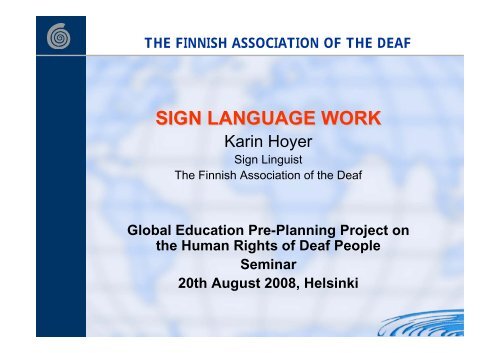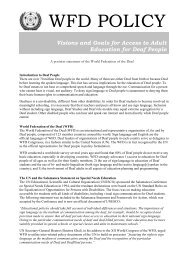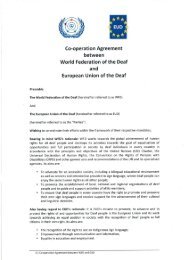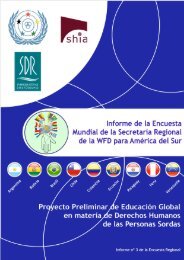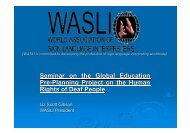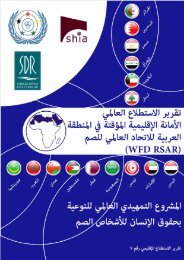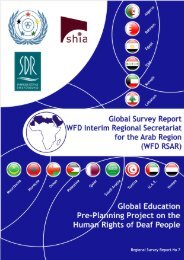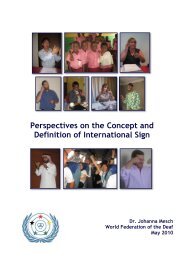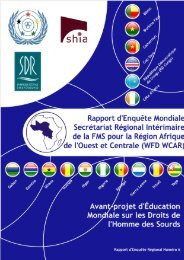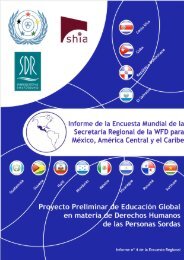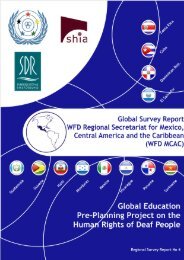SIGN LANGUAGE WORK - World Federation of the Deaf
SIGN LANGUAGE WORK - World Federation of the Deaf
SIGN LANGUAGE WORK - World Federation of the Deaf
Create successful ePaper yourself
Turn your PDF publications into a flip-book with our unique Google optimized e-Paper software.
THE FINNISH ASSOCIATION OF THE DEAF<br />
<strong>SIGN</strong> <strong>LANGUAGE</strong> <strong>WORK</strong><br />
Karin Hoyer<br />
Sign Linguist<br />
The Finnish Association <strong>of</strong> <strong>the</strong> <strong>Deaf</strong><br />
Global Education Pre-Planning Project on<br />
<strong>the</strong> Human Rights <strong>of</strong> <strong>Deaf</strong> People<br />
Seminar<br />
20th August 2008, Helsinki
THE FINNISH ASSOCIATION OF THE DEAF<br />
My background:<br />
• No <strong>Deaf</strong> family background but a member <strong>of</strong> a linguistic<br />
minority. Swedish-speakers are 6 % <strong>of</strong> <strong>the</strong> population <strong>of</strong><br />
Finland<br />
• Sign language interpreter degree in 1993<br />
• MA in linguistics 1999<br />
• PhD-student in General Linguistics at University <strong>of</strong> Helsinki<br />
• 1998 – 2002 Finland-Swedish Sign Language research project<br />
• 2002 Linguistic advisor –> Sign Language Work (SLW) in<br />
Balkan (Albania and Kosovo) in two development co-operation<br />
projects funded by <strong>the</strong> Ministry for Foreign Affairs <strong>of</strong> Finland<br />
and <strong>the</strong> Finnish Association <strong>of</strong> <strong>the</strong> <strong>Deaf</strong><br />
• The Finnish Association <strong>of</strong> <strong>the</strong> <strong>Deaf</strong> (FAD)<br />
• Albanian National Association <strong>of</strong> <strong>the</strong> <strong>Deaf</strong> (ANAD)<br />
• Kosovar Association <strong>of</strong> <strong>the</strong> <strong>Deaf</strong> (KAD)
THE FINNISH ASSOCIATION OF THE DEAF
THE FINNISH ASSOCIATION OF THE DEAF<br />
The aim <strong>of</strong> this presentation:<br />
• The relationship between Sign Language<br />
Work and o<strong>the</strong>r development co-operation<br />
areas<br />
• Discuss Sign Language Work in FAD<br />
development co-operation projects on<br />
Balkan:<br />
– Methods<br />
– Challenges<br />
–Results<br />
–Ethics<br />
• To comment on <strong>the</strong> Global survey (draft)<br />
reports concerning standardisation <strong>of</strong> sign<br />
languages and dictionary work
THE FINNISH ASSOCIATION OF THE DEAF<br />
• Sign language is repressed in many countries and its<br />
use is not permitted in education. The consequence is<br />
that <strong>Deaf</strong> people are not aware <strong>of</strong> <strong>the</strong> rights <strong>the</strong>y have in<br />
society, but live as a highly marginalised group in most<br />
developing countries. There is usually no access to<br />
information for <strong>Deaf</strong> people, which means that <strong>the</strong>y do<br />
not even know what is happening in <strong>the</strong>ir immediate<br />
society and even less so in <strong>the</strong> world. Of <strong>the</strong> world's<br />
<strong>Deaf</strong> people only about five percent (5%) can read and<br />
write. This is due to <strong>the</strong> fact that <strong>Deaf</strong> people have not<br />
been educated in sign language. Improving <strong>the</strong> status<br />
<strong>of</strong> sign language has consequences for all areas <strong>of</strong> life<br />
for <strong>Deaf</strong> people, it opens up possibilities for participation,<br />
information and influence and reduction <strong>of</strong> poverty.<br />
Quotation from Colin Allen (2008: 8) Global Survey Draft Report, WFD<br />
Eastern Europe and Middle Asia Regional Secretariat
THE FINNISH ASSOCIATION OF THE DEAF<br />
Why Sign Language Work in<br />
development co-operation work?<br />
• The goals are to increase opportunities<br />
enabling <strong>Deaf</strong> people to achieve equal<br />
human rights as hearing people; and to<br />
become active participants <strong>of</strong> society;<br />
and to lead an independent life by<br />
promoting <strong>the</strong> status <strong>of</strong> <strong>the</strong> national<br />
sign languages AlbSL and KosSL.
THE FINNISH ASSOCIATION OF THE DEAF<br />
7. Priority areas for <strong>the</strong> co-operation:<br />
The WFD recommends <strong>the</strong> following to be<br />
given priority in co-operation work:<br />
• Establishment/streng<strong>the</strong>ning <strong>of</strong> an<br />
organisation <strong>of</strong> <strong>the</strong> <strong>Deaf</strong><br />
• Sign language work<br />
• Education<br />
• Income generating and vocational training<br />
• Labour market<br />
WFD POLICY_Work Done by Member Organisations in Developing<br />
Countries:
THE FINNISH ASSOCIATION OF THE DEAF<br />
The Goals and Role <strong>of</strong> <strong>the</strong> <strong>World</strong> <strong>Federation</strong> <strong>of</strong> <strong>the</strong><br />
<strong>Deaf</strong> (WFD):<br />
– To promote recognition <strong>of</strong> sign language and <strong>the</strong> right <strong>of</strong><br />
<strong>Deaf</strong> individuals to use sign language;<br />
– To promote <strong>the</strong> right <strong>of</strong> <strong>Deaf</strong> children to have early and full<br />
access to sign language;<br />
– To promote increased support for sign language research;<br />
– To promote better quality <strong>of</strong> teaching <strong>of</strong> sign language;<br />
– To promote better quality <strong>of</strong> sign language interpreting;<br />
– To promote more availability <strong>of</strong> sign language in <strong>the</strong> media.<br />
WFD Sign Language Fact Sheet<br />
THE FINNISH ASSOCIATION OF THE DEAF<br />
Colin Allen (2008): Global Survey Draft<br />
Reports:<br />
• Highest priority issues all needs Sign<br />
Language Work<br />
– Better quality <strong>of</strong> <strong>Deaf</strong> Education<br />
– Better Sign Language Interpreting quality<br />
and services<br />
– Official recognition from national<br />
Governments <strong>of</strong> <strong>the</strong>ir country’s Sign<br />
Language
THE FINNISH ASSOCIATION OF THE DEAF<br />
What is Sign Language Work?<br />
– Language documentation and basic sign language<br />
research<br />
– Application <strong>of</strong> <strong>the</strong> research results into dictionary work or<br />
o<strong>the</strong>r kind <strong>of</strong> publications, like teaching materials<br />
– Linguistic awareness training for <strong>the</strong> <strong>Deaf</strong> community<br />
– Training in sign language structure and grammar for sign<br />
language interpreter students<br />
– Training <strong>Deaf</strong> research assistants in how to teach sign<br />
language as a foreign language to hearing people.<br />
Implementing <strong>the</strong> teaching toge<strong>the</strong>r with <strong>the</strong> assistants.<br />
– Linguistic advocacy work for legal recognition <strong>of</strong> sign<br />
language and for improving existing legislation<br />
– Establishing contacts to universities and promoting<br />
research in sign language
THE FINNISH ASSOCIATION OF THE DEAF<br />
• In development support work <strong>the</strong><br />
implementation <strong>of</strong> Sign Language Work is<br />
dependant <strong>of</strong> <strong>the</strong> wider social context, <strong>the</strong><br />
country’s history, <strong>the</strong> situation with sign<br />
language, national legislation, and <strong>the</strong><br />
priorities made by <strong>the</strong> <strong>Deaf</strong> community<br />
• Important to have a sign linguist involved
THE FINNISH ASSOCIATION OF THE DEAF<br />
Why can Sign Language Work be seen as a<br />
precondition for many o<strong>the</strong>r development cooperation<br />
areas?<br />
• If you do not have research in and information about<br />
<strong>the</strong> national sign language how can you:<br />
– Train teachers <strong>of</strong> <strong>the</strong> <strong>Deaf</strong> towards improving <strong>Deaf</strong><br />
education<br />
– Train and develop a pool <strong>of</strong> high quality sign language<br />
interpreters<br />
– Teach <strong>Deaf</strong> people and improve <strong>the</strong>ir linguistic awareness<br />
– Produce materials or lobby for its legal recognition?
Advocacy<br />
work<br />
- Legislation and policies<br />
- Access to service and<br />
information<br />
- Promote <strong>the</strong> use <strong>of</strong><br />
sign language in<br />
media<br />
Interpreter<br />
Training<br />
-Tranining for students<br />
in SL and SL grammar<br />
- Programmes for <strong>Deaf</strong> to<br />
become SL interpreters and<br />
translators<br />
Sign<br />
Language<br />
Work<br />
<strong>Deaf</strong> Education<br />
- (Sign language)<br />
training programmes<br />
for teachers and<br />
teacher students<br />
- Planning, implementing<br />
and evaluation <strong>of</strong><br />
education programmes<br />
and curricula<br />
Organisational<br />
development<br />
work<br />
- Linguistic Awareness<br />
Training for <strong>the</strong> <strong>Deaf</strong><br />
community<br />
FAD; Hoyer & Lahtinen, 2007
THE FINNISH ASSOCIATION OF THE DEAF<br />
Methods in Sign Language Work:<br />
• Balkan Sign Language Work is implemented by <strong>Deaf</strong> research<br />
assistants + working group with representatives from <strong>the</strong> whole<br />
<strong>Deaf</strong> community<br />
• Precondition for success is to recruit <strong>Deaf</strong> persons with good<br />
potential (learning abilities and good signing skills) as research<br />
assistants<br />
• The relation between TRAINING and RESEARCH<br />
• Learning by doing. Basic vocabulary research done by <strong>the</strong> sign<br />
language research assistants<br />
• Interactive teaching methods, mistakes allowed. Learn by<br />
practice and by teaching o<strong>the</strong>rs (working group members)<br />
• Concrete visual tools (sign cards, prints, and drawings on <strong>the</strong><br />
wall)
THE FINNISH ASSOCIATION OF THE DEAF<br />
• <strong>Deaf</strong> community commitment crucial. <strong>Deaf</strong><br />
community shall feel ownership towards <strong>the</strong> work<br />
• Linguistic advisor present 2-6 weeks 3 times/ one<br />
year/ each project<br />
• Important that <strong>the</strong> linguistic skills are transferred to<br />
<strong>the</strong> <strong>Deaf</strong> assistants and <strong>the</strong> working group members<br />
for <strong>the</strong> work not to collapse when no advisor is<br />
present<br />
• Relationship between foreign advisor – local<br />
research assistants and working group members<br />
• Keys to successful work:<br />
– Communication in <strong>the</strong> local sign language<br />
– Advisor should be aware <strong>of</strong> her/his own language
THE FINNISH ASSOCIATION OF THE DEAF<br />
3. Development <strong>of</strong> Co-operation between <strong>Deaf</strong> associations in<br />
Developing and Developed Countries<br />
• The WFD will work towards a situation whereby:<br />
• A. <strong>Deaf</strong> Associations in developed countries are encouraged to enter<br />
into a partnership/co-operation with counterparts in <strong>the</strong> south.<br />
• B. The co-operation should as much as possible be based on <strong>the</strong><br />
principle <strong>of</strong> mutual respect for cultural, language and social economic<br />
realities, e.g. in sign language work. The objective should not be to<br />
export <strong>the</strong> sign language <strong>of</strong> <strong>the</strong> developed countries, but for<br />
developing countries to research and/or develop <strong>the</strong>ir own sign<br />
languages based on cultural realities.<br />
• C. <strong>Deaf</strong> people from developing countries should be encouraged to<br />
receive training in specific areas (e.g. sign language and<br />
management) in developed countries. However, <strong>the</strong> training should be<br />
tailored to enable <strong>the</strong>m to work with <strong>the</strong> languages in <strong>the</strong>ir own<br />
countries.<br />
WFD POLICY_WFD Work in Developing countries<br />
THE FINNISH ASSOCIATION OF THE DEAF<br />
• Colin Allen (2008: 18) Global Survey Draft Report,<br />
WFD Interim Regional Secretariat for Western and<br />
Central Africa:<br />
• Six countries (Benin, Cape Verde, Chad, Senegal,<br />
Sierra Leone and Togo) do not lobby for recognition<br />
<strong>of</strong> <strong>the</strong>ir sign language due to:<br />
– Political conflict in <strong>the</strong> country;<br />
– Sign language does not exist in <strong>the</strong> country;<br />
– American Sign Language is accepted and not opposed to<br />
by <strong>the</strong> authorities;<br />
– Philosophical conflicts about sign language within <strong>the</strong> <strong>Deaf</strong><br />
Community; and<br />
– The national sign language does not have <strong>of</strong>ficial status but<br />
American Sign Language is used, using French concepts.
THE FINNISH ASSOCIATION OF THE DEAF<br />
Keys to successful work (continue):<br />
• Mutual respect, Flexibility, cultural sensitivity<br />
• Language policy in <strong>the</strong> <strong>of</strong>fice concerning <strong>the</strong> use <strong>of</strong><br />
sign language. Advisor role model for hearing<br />
people<br />
• A conscious approach to use only <strong>Deaf</strong> language<br />
users in <strong>the</strong> documentation work for dictionary work<br />
• To avoid <strong>the</strong> influence from hearing non-signers<br />
• To promote <strong>the</strong> self-esteem <strong>of</strong> <strong>the</strong> <strong>Deaf</strong> community
THE FINNISH ASSOCIATION OF THE DEAF<br />
• Research method: documentation <strong>of</strong> real language<br />
use – word lists not in use<br />
• Never 1:1 correspondence between signs and<br />
words<br />
• “thumbs up” – good, fine, nice, well, bravo!, ok<br />
• Visual dictionaries (VHS, dvd or Internet) for <strong>the</strong><br />
publication to show how <strong>the</strong> sign language actually<br />
look and move<br />
• Sign language is as adequate as a spoken language<br />
– Video reports in sign language<br />
– No written language in common for<br />
communication on distance – Fast Internet
THE FINNISH ASSOCIATION OF THE DEAF<br />
• Tools for depicting <strong>the</strong> documented signs<br />
• Drawing from <strong>the</strong> TV or computer screen<br />
• On <strong>the</strong> Internet <strong>the</strong>re is free downloadable programmes for<br />
depicting signs with computer<br />
– VirtualDub for video capturing<br />
– The graphics editor programmes GIMP and Incscape<br />
– Lay-out programme Scribus<br />
• Important to see both <strong>the</strong> ”big picture” <strong>of</strong> dictionary work as <strong>the</strong><br />
individual parts in <strong>the</strong> process<br />
• Successful work needs good planning!<br />
• Sign language processes are based on local co-operation (e.g.<br />
dictionary work, or lobbying for recognition <strong>of</strong> Sign language in<br />
<strong>the</strong> legislation)<br />
• The work needs involvement <strong>of</strong> O = organisational work<br />
towards <strong>the</strong> <strong>Deaf</strong> community, SLW, A= advocacy work, and<br />
INT= interpreters
DICTIONARY<br />
Editing video/<br />
dvd interface<br />
SLW ?<br />
Work<br />
with spoken language<br />
equivalents<br />
SLW<br />
INT<br />
Information<br />
<strong>Deaf</strong> community<br />
Hearing network<br />
Book<br />
preface, index, layout<br />
printing<br />
SLW<br />
SLW INT<br />
?<br />
Translation <strong>of</strong><br />
sentences into<br />
spoken language<br />
SL Working group<br />
Videotape<br />
discussion on signs,<br />
signs and sentences<br />
<strong>the</strong>ir form and use<br />
SLW O SLW O<br />
Lobby University<br />
SL research<br />
-> SL gets<br />
document SL use<br />
linguistic status<br />
SLW O SLW O/A INT<br />
INT<br />
FAD; Hoyer & Lahtinen, 2007
RECOGNITION OF<br />
NATIONAL <strong>SIGN</strong> <strong>LANGUAGE</strong> IN LEGISLATION<br />
<strong>Deaf</strong> give training<br />
to <strong>Deaf</strong> community<br />
-> tools for lobbying<br />
to hearing network<br />
SLW O/A INT<br />
Applied research<br />
dictionaries,<br />
information material<br />
SLW O INT<br />
Advocacy and lobbying<br />
<strong>Deaf</strong> community members lobby locally,<br />
<strong>Deaf</strong> organisation lobby government<br />
-> change in legislation<br />
SLW O/A INT<br />
Advisors train <strong>Deaf</strong> trainers<br />
Linguistic rights, SL grammar<br />
legislation structure, pedagogy<br />
SLW O/A<br />
INT<br />
Lobby University<br />
-> SL gets<br />
SL research<br />
linguistic status<br />
document SL<br />
SLW O SLW O/A INT<br />
FAD; Hoyer & Lahtinen, 2007
THE FINNISH ASSOCIATION OF THE DEAF<br />
Challenges in Sign Language Work:<br />
• Realistic planning!!<br />
• Time management<br />
– 3 years is a short time for Sign Language Work<br />
– Learning totally new concepts takes time<br />
– There is a limit to what you can learn at one time<br />
• Balance between focusing on sign level (=dictionary work) and<br />
grammar <strong>of</strong> sign language, since one <strong>of</strong> <strong>the</strong> most common<br />
misconceptions about sign languages is that <strong>the</strong> signs are<br />
articulated according to <strong>the</strong> word order <strong>of</strong> <strong>the</strong> surrounding<br />
spoken language<br />
• Cultural differences<br />
• How to commit <strong>the</strong> working group members to a long-term<br />
work on voluntary basis
THE FINNISH ASSOCIATION OF THE DEAF<br />
Results in or as a consequence <strong>of</strong> Sign Language<br />
Work:<br />
• Overt:<br />
– Dictionaries, o<strong>the</strong>r materials about, and in, sign language<br />
– In Albania: National news bulletin translated into AlbSL by<br />
<strong>Deaf</strong> translators<br />
• Covert:<br />
– Skills in sign linguistics<br />
– Risen linguistic awareness (<strong>Deaf</strong>, family members,<br />
interpreters, teachers, hearing network)<br />
– Sign language skills (teachers, interpreters)
THE FINNISH ASSOCIATION OF THE DEAF<br />
Ethics in Sign Language Work:<br />
• Consent for video filming<br />
• Research methods<br />
– Democratic and transparent<br />
– Community based – gender, age and<br />
regional balance
THE FINNISH ASSOCIATION OF THE DEAF<br />
• Quotation from Evaluation Report (2008) <strong>of</strong> FAD<br />
project in Kosovo for <strong>the</strong> successes <strong>of</strong> SLW:<br />
8.1.2. Effective <strong>Deaf</strong> community<br />
involvement/ownership<br />
• A previous exercise to develop a book <strong>of</strong> Kosovar<br />
Signs in 2002 met with great resistance, antagonism<br />
and rejection from many members <strong>of</strong> <strong>the</strong> <strong>Deaf</strong><br />
community. (This work had been led by individuals<br />
with no training in sign linguistics and is regarded as<br />
unscientific) To ensure consensus on <strong>the</strong> work <strong>of</strong><br />
<strong>the</strong> present sign language research team, <strong>the</strong><br />
volunteer working group, from different geographical<br />
and social backgrounds and <strong>of</strong> varying ages and<br />
gender will collectively be responsible for producing<br />
<strong>the</strong> DVD and booklet in 2009.
THE FINNISH ASSOCIATION OF THE DEAF<br />
The external evaluator observed a training session for two <strong>of</strong> <strong>the</strong> <strong>Deaf</strong><br />
working group volunteers and was impressed by <strong>the</strong> careful<br />
explanations <strong>of</strong> <strong>the</strong> need for ethical consistency, consent and<br />
technical information. It is commendable to see that this group <strong>of</strong><br />
volunteers demonstrates considerable commitment, <strong>of</strong>ten having to<br />
travel long and difficult distances to attend training meetings.<br />
The Working Group is also active in disseminating information about <strong>the</strong><br />
sign language work to o<strong>the</strong>r members <strong>of</strong> <strong>the</strong> <strong>Deaf</strong> community:<br />
‘I was always told by hearing people that I couldn’t do things – that <strong>the</strong>y<br />
were smarter. Now I understand that it is a language issue’<br />
‘Knowing it is a real language gives me confidence’<br />
This has had an impact on <strong>the</strong> self-esteem <strong>of</strong> <strong>Deaf</strong> people in Kosovo.<br />
Said one hearing observer:<br />
‘We never saw people signing before <strong>the</strong> War – now <strong>the</strong>y are confident to<br />
use it. (Sign language)’
THE FINNISH ASSOCIATION OF THE DEAF<br />
Language planning and language standardization<br />
work for sign languages:<br />
• Colin Allen (2008: 23) Global Survey Draft Report, WFD Regional<br />
Secretariat for Asia and <strong>the</strong> Pacific:<br />
• Common areas <strong>of</strong> concern: ---<br />
Sign Language<br />
• <strong>Deaf</strong> people have no sign language skills.<br />
• Government does not recognise <strong>the</strong> sign language.<br />
• Sign language materials and courses should be provided for<br />
<strong>Deaf</strong> people who have not learned <strong>the</strong>ir own language.<br />
• The promotion <strong>of</strong> Human Rights through Sign Languages<br />
needs to be streng<strong>the</strong>ned.<br />
• Need to standardise <strong>the</strong> national sign language.
THE FINNISH ASSOCIATION OF THE DEAF<br />
• Colin Allen (2008: 22) Global Survey Draft Report,<br />
WFD Interim Regional Secretariat for Western and<br />
Central Africa<br />
• Common areas <strong>of</strong> concern: ---<br />
Sign Language<br />
• Government does not recognise <strong>the</strong><br />
sign language.<br />
• Standardised sign language.
THE FINNISH ASSOCIATION OF THE DEAF<br />
• Unification – Standardization<br />
• see WFD POLICY_ WFD Statement on <strong>the</strong> Unification<br />
<strong>of</strong> Sign Languages<br />
)<br />
• WFD opposes all attempts to unify several sign<br />
languages to a single sign language<br />
• WFD also opposes purification <strong>of</strong> <strong>the</strong> language from<br />
outside <strong>the</strong> community – it is a natural process that<br />
languages change over time and that new signs gets<br />
adopted into <strong>the</strong> languages<br />
• “The control <strong>of</strong> <strong>the</strong> development <strong>of</strong> any Sign Language<br />
must be left to any social group where <strong>the</strong> particular<br />
Sign Language is exercised.”
THE FINNISH ASSOCIATION OF THE DEAF<br />
• Native sign language users use different form <strong>of</strong><br />
language in different situations<br />
• Compare e.g. <strong>the</strong> language used in private<br />
conversations to <strong>the</strong> language used in seminar<br />
presentations<br />
When is a standard variety <strong>of</strong> sign language used?<br />
• Public, “<strong>of</strong>ficial” purposes, like TV news,<br />
Government information on <strong>the</strong> web<br />
• When producing teaching materials <strong>the</strong>re might be<br />
an conscious effort to use a standard variety<br />
• In dictionary work <strong>the</strong> aim might be to describe<br />
standard language instead <strong>of</strong> regional dialects
THE FINNISH ASSOCIATION OF THE DEAF<br />
• Standardization work is usually associated with writing and<br />
literacy – <strong>the</strong> “right” way to write <strong>the</strong> language according to<br />
grammars and dictionaries<br />
• Signed languages are <strong>of</strong>ten compared to written languages<br />
that are more standardized than spoken languages<br />
• It is within <strong>the</strong> nature <strong>of</strong> a language that does not have a<br />
written form to have a big amount <strong>of</strong> variation<br />
• Making a dictionary is standardization work in <strong>the</strong> way that not<br />
all <strong>the</strong> signs <strong>of</strong> <strong>the</strong> language is included in <strong>the</strong> dictionary<br />
• The chosen sign might in <strong>the</strong> future be considered more “right”<br />
than o<strong>the</strong>r signs, since <strong>the</strong>y are recorded in <strong>the</strong> dictionary<br />
• The dictionary makers <strong>of</strong> AlbSL wanted to show variation in <strong>the</strong><br />
language by including variants <strong>of</strong> <strong>the</strong> same concept (see e.g.<br />
signs 34, 35, 37, 38 for ‘bro<strong>the</strong>r’). The AlbSL dictionary was<br />
descriptive and not prescriptive
THE FINNISH ASSOCIATION OF THE DEAF<br />
• “Need to standardize <strong>the</strong> national sign language.” Whose<br />
need?<br />
• A standard variety <strong>of</strong> a language is usually promoted in<br />
education and in <strong>the</strong> media. Existence <strong>of</strong> a standard form might<br />
be used as a condition for <strong>of</strong>ficial recognition <strong>of</strong> <strong>the</strong> language<br />
or for its use as a language <strong>of</strong> instruction<br />
• It seems that <strong>the</strong> impetus to standardize sign languages<br />
usually come from <strong>the</strong> desire <strong>of</strong> hearing persons, not <strong>Deaf</strong><br />
persons, e.g. in <strong>the</strong>ir learning process.<br />
• Teachers and interpreters might think that <strong>the</strong>re should only be<br />
one sign for each word. This opinion reveals ignorance about<br />
sign languages<br />
• The standardization desire is focused on individual signs<br />
• Usually <strong>Deaf</strong> signers have no problem understanding each<br />
o<strong>the</strong>r, even if <strong>the</strong>y use different signs.
THE FINNISH ASSOCIATION OF THE DEAF<br />
• There is never a one-to-one relationship between<br />
languages. A word can have many sign equivalents<br />
and a sign can have many word equivalents<br />
• Each language is tied to a specific culture, sign<br />
languages reflect <strong>Deaf</strong> culture. There is a lot <strong>of</strong><br />
signs that do not have an one word equivalent, but<br />
must be translated by using a longer expression<br />
• The decision <strong>of</strong> whe<strong>the</strong>r to standardize a sign<br />
language or not, is to be made by <strong>the</strong> language<br />
users <strong>the</strong>mselves<br />
• Variation is a natural part <strong>of</strong> language
THE FINNISH ASSOCIATION OF THE DEAF<br />
• Questionnaire question: 7.7.2 Does your country<br />
have a sign language dictionary?<br />
• Why is a dictionary important?<br />
– For giving status to <strong>the</strong> language – it exists -> you can get<br />
legal recognition <strong>of</strong> <strong>the</strong> language.<br />
• Ulrike Mosel (2006: 68): In community language<br />
work among indigenous people <strong>of</strong> spoken<br />
languages a dictionary ranks highest on <strong>the</strong>ir list <strong>of</strong><br />
priorities<br />
• SL dictionaries:<br />
– Who have been involved compiling it?<br />
– Does it give a fair picture <strong>of</strong> <strong>the</strong> SL?<br />
– How is <strong>the</strong> visual language presented? In still drawings or<br />
pictures? In live form?<br />
– Who is it made for?
THE FINNISH ASSOCIATION OF THE DEAF<br />
• Wishes for <strong>the</strong> future for developing Sign<br />
Language Work:<br />
• Language Policy Programme (WFD Statement on<br />
<strong>the</strong> Unification <strong>of</strong> Sign Languages – Good!)<br />
• Handbook on Sign Language Work with guidelines,<br />
for not everybody to having to re-invent <strong>the</strong> wheel
THE FINNISH ASSOCIATION OF THE DEAF<br />
• That burning urge to find out formed <strong>the</strong> basis <strong>of</strong> my first<br />
interest in Sign Language. As I read and asked questions<br />
about <strong>the</strong> language, I came to realize that <strong>the</strong> <strong>Deaf</strong> were<br />
perhaps <strong>the</strong> most misunderstood language minority anywhere<br />
in <strong>the</strong> world. This realization changed my interest from mere<br />
curiosity to a sense <strong>of</strong> mission. Hearing people <strong>of</strong>ten talk about<br />
<strong>the</strong> rehabilitation <strong>of</strong> <strong>the</strong> <strong>Deaf</strong>. Now, it seems to me, what one<br />
ought to talk about is not <strong>the</strong> rehabilitation, but <strong>the</strong> liberation <strong>of</strong><br />
<strong>the</strong> <strong>Deaf</strong>.<br />
• I believe <strong>the</strong> science <strong>of</strong> linguistics has a significant role to play<br />
in that liberation struggle.<br />
• Okoth Okombo (1990: 59)
THE FINNISH ASSOCIATION OF THE DEAF<br />
Some references:<br />
• Allen, Colin (2008) Global Survey Draft Report, WFD Eastern Europe and<br />
Middle Asia Regional Secretariat<br />
• Allen, Colin (2008) Global Survey Draft Report, WFD Interim Regional<br />
Secretariat for Western and Central Africa<br />
• Allen, Colin (2008) Global Survey Draft Report, WFD Regional Secretariat for<br />
Asia and <strong>the</strong> Pacific<br />
• Dotter, Franz, 'S<strong>of</strong>t' standardization <strong>of</strong> sign languages?<br />
• Gibson, Liz Scott & Nexhat Shatri (2008) Report from <strong>the</strong> Evaluation <strong>of</strong> <strong>the</strong><br />
Organisational Training and Sign Language Development Projects in Kosovo.<br />
• Mosel, Ulrike (2006). Fieldwork and community language work. In Essentials <strong>of</strong><br />
Language Documentation, edited by Gippert, Himmelmann & Mosel<br />
• Okombo, Okoth (1990) Linguistics and <strong>the</strong> Liberation <strong>of</strong> <strong>the</strong> Kenyan <strong>Deaf</strong>:<br />
Some Research Agenda for Sign Language Developers. In East African Sign<br />
Language Seminar 20–26.8.1990 Report<br />
• WFD Sign Language Fact Sheet<br />
<br />
• WFD POLICY_WFD Work in Developing countries<br />
<br />
• WFD POLICY _Work Done by Member Organisations in Developing Countries<br />
<br />
• WFD POLICY_ WFD Statement on <strong>the</strong> Unification <strong>of</strong> Sign Languages<br />


